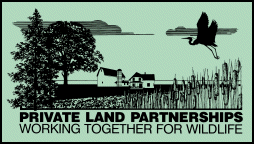 |
|
HOMES FOR WILDLIFE
|
Wildlife depends on four habitat components for survival: food,
water, cover, and space. Depending on the species, the amount and type of each of
these components varies. This chapter will focus on one of these components, that of
cover. Cover types could vary from woodlands to grasslands
to wetlands. After assessing what
cover types are available on your property, you can determine what species you will be
able to attract. If cover is not present, but other habitat components for a species are,
then adding cover may make your yard more attractive to certain species of wildlife. By
planting trees, shrubs, grasses, and flowers, you can provide cover and attract even more
wildlife. In doing so, you will provide a more diverse habitat, and increase the
likelihood of attracting wildlife by meeting all four of the habitat components.
Providing homes for wildlife will help fulfill their cover requirements. Wildlife homes
can be either vegetative (grasses, shrubs,
trees) or structural (stones, underground dens, brush piles, nest boxes, cylinders). These
homes offer protection from not only predators,
but also weather elements such as cold winter winds or hot summer days. Birds use these
homes for shelter, nesting, and brood rearing. This chapter explains what
homes can be provided for wildlife to enhance the cover on your property. The supplemental
chapter Homes for Wildlife II provides the plans for the
homes described here. Refer to the chapter on Bird
and Other Wildlife Feeders for information on how to provide the habitat component
of food to your backyard.
Vegetative Homes
There are many types of natural homes that you can provide for wildlife on your
property. In addition to planting trees, shrubs, and grasses that provide a variety of
wildlife with places to nest, seek shelter, and raise their young, there may also be other
natural homes that could be created on your land that also provide cover for
wildlife.
Snags
Snags are standing, dead, or dying
trees, which provide excellent natural homes for a variety of wildlife. Wildlife that
inhabit these snags, such as woodpeckers, nuthatches, bluebirds, squirrels, and raccoons, are called cavity
nesters. The type of wildlife that inhabit these snags will also depend on the kind, size,
and location of the snag.
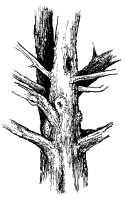 There are
two basic kinds of snags: hard or soft. Hard snags have rotten centers with a solid
exterior and a few limbs. These usually make the best den trees as the center can be
easily excavated to form a home. Trees that usually form good cavities are large hardwoods
that decay slowly such as sugar maple, elm, black and white oak, hickory, and butternut.
Soft snags have softer exterior wood, and usually have no limbs. These snags usually make
good foraging sites for insect-eating birds, as well as nesting sites for woodpeckers,
chickadees, and nuthatches. Trees that often form soft snags have short life spans, and
rot quickly. These too are important to wildlife as they produce cavities more quickly
than harder wood, as well as habitat for many insects that provide food for birds,
mammals, amphibians, and reptiles. Coniferous snags do not usually last as long as
hardwoods, and are usually not used for den trees. One exception to this is northern white
cedar, as it makes an excellent cavity tree. Other conifers, such as white pine and
tamarack, make excellent nest and perch sites for eagles and osprey when located next to
water. There are
two basic kinds of snags: hard or soft. Hard snags have rotten centers with a solid
exterior and a few limbs. These usually make the best den trees as the center can be
easily excavated to form a home. Trees that usually form good cavities are large hardwoods
that decay slowly such as sugar maple, elm, black and white oak, hickory, and butternut.
Soft snags have softer exterior wood, and usually have no limbs. These snags usually make
good foraging sites for insect-eating birds, as well as nesting sites for woodpeckers,
chickadees, and nuthatches. Trees that often form soft snags have short life spans, and
rot quickly. These too are important to wildlife as they produce cavities more quickly
than harder wood, as well as habitat for many insects that provide food for birds,
mammals, amphibians, and reptiles. Coniferous snags do not usually last as long as
hardwoods, and are usually not used for den trees. One exception to this is northern white
cedar, as it makes an excellent cavity tree. Other conifers, such as white pine and
tamarack, make excellent nest and perch sites for eagles and osprey when located next to
water.
In general, regardless of the kind of snag, the larger it is the more wildlife it can
support. The best den trees, live or dead, are over 15 inches diameter at breast height
(DBH) with a den opening of four inches or more. Keep an eye out for trees that appear to
be potential snags. These trees have large, sprawling branches, and often are fruit and
nut producers. Missing or bare branches, fungal growth, wounds, and discolored bark are
all signs of a dying tree. Also, look for woodpecker holes, which usually indicate a
rotting core.
If you do not have any snags on your property, consider creating some. Remember that it
will take a while before newly created snags will be suitable for wildlife. Therefore, to
speed up the process, try to pick trees that appear to be dying, and that are over a foot
in diameter. With an axe, cut away a two inch band of bark around the entire circumference
of the trunk, removing the bark and cutting into the sapwood. This is known as girdling, and will kill the tree as it
disrupts the flow of nutrients. To simply create a den, cut off a four to six inch limb
about six inches from the trunk. This will wound the tree and allow the decaying process
to start, eventually forming a cavity where the limb was cut.
The kinds of wildlife your snag will attract will also depend on where it is located.
Snags are most commonly associated with forests. Many forest mammals, such as bats, bobcats, bears, pine martens, porcupines, red
squirrels, and gray foxes, use snags for dens and lookouts. Forest birds also frequently
use these snags; woodpeckers are usually the primary excavators. Other birds, such as the
saw-whet owl, black-capped chickadee, nuthatch, and great-crested flycatcher, move in once
the home is vacated. A snag located on a waterway or wetland will attract a different
variety of wildlife. Wood ducks, hooded mergansers, common goldeneyes, and buffleheads use
cavities for nesting, while herons, egrets, eagles, and osprey use tall snags for nesting
and lookouts. Snags in open fields will provide lookouts for some types of hawks and owls,
and homes for flickers, kestrels, and eastern bluebirds. A snag in a backyard setting will
provide homes for house wrens, black-capped chickadees, red-bellied woodpeckers, and
flying squirrels.
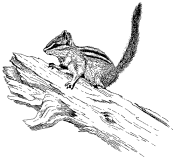 Fallen Logs Fallen Logs
Fallen logs are snags that have toppled over or healthy trees that were felled, usually
by windthrow. Once these trees fall to the ground, they do not lose their value to
wildlife. On the contrary, they are highly beneficial. Fallen logs in or near water
provide cover for various species of fish. Male ruffed grouse use fallen logs in their
attempts to attract females with their springtime courtship drumming. Chipmunks use fallen
logs as runways through the forest. Hollow logs will be used by a number of species for
dens, especially in the winter. If the log is big enough, foxes and even bears will use it
for this purpose. As the log becomes more decayed it becomes home to salamanders, moles,
shrews, earthworms, and many kinds of insects. Eventually, these fallen logs will
regenerate the forest as they return to the soil, providing rich nutrients for new plants to grow from.
Structural Homes
Vegetative homes may take several years to become suitable for wildlife. Therefore, you
may want to create structural homes for wildlife that may be more quickly occupied.
Structural homes are those that are not grown, but are instead arranged in some manner to
create cover for wildlife. This could mean that the structure was arranged naturally, such
as a natural brush or rock pile. Providing structural homes will help to diversify your
yard, as it will supply a ready-to-use home for wildlife.
Brush Piles
Brush piles, which consist of dead limbs and brush, will provide many species, such as
rabbits, chipmunks, ground-nesting birds, amphibians, and reptiles, with escape cover.
Brush piles are most beneficial when placed along habitat edges and near food sources.
However, do not place a brush pile at the base of a snag, as this will promote predation.
The base of the brush pile should consist of larger materials such as logs or rocks, so as
to provide tunnels and openings at ground level. The pile should be six to eight feet tall
and at least 15 feet wide. "Living" brush piles can be constructed by cutting
into small, trees and shrubs so that the tops fall to the ground, while enough of the tree
is uncut so it remains alive, forming a base for a larger brush pile. A brush pile that is
buried underground forms a hibernation mound for snakes. Refer to the chapters on Rabbits, and Frogs, Turtles and Snakes for
further information.
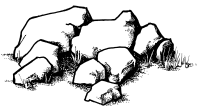 Rock
Piles Rock
Piles
Rock piles provide another form of cover for several species. Rock piles near wet areas
or in gardens are especially appealing to those species that require moist, shaded areas
such as frogs, snakes, salamanders, and insects. In areas near habitat edges, species such
as rabbits and chipmunks will use the piles as escape cover.
Nest boxes
Artificial houses provide nesting sites for many species of birds and mammals. These
nest boxes are usually wooden rectangular boxes of various sizes. Different species also
require different sized entrance holes. Making the house for a specific species will
lessen competition for nesting
sites. A hinged side or roof should be provided, as it will allow for easy access for
cleaning. Also, avoid houses made of metal as they overheat in warm weather, killing bird
eggs. Do not use birdhouses with perches as this promotes invasion by exotic bird species such as
house sparrows and starlings. These birds are not federally protected, and should be
removed whenever possible as they will kill native birds and take over nest boxes.
A nest box that is 5 1¼2 x 11 1¼2 inches in size will attract house wrens,
black-capped chickadees, white-breasted nuthatches, mice, and flying squirrels. House
wrens nest in wooded, shrubby habitats and are one of the most common backyard birds.
Their nest boxes are best placed five to 20 feet above the ground, and in a tree or under
the eaves of a building. The entrance should be one inch in diameter. Wren houses can be
free hanging and should not have a perch. Mice will also use these sized houses for winter
dens. Beware that this may prevent birds from using the house when they return in the
spring. Black-capped chickadees will nest in these boxes in areas that have mature
trees. Their nest boxes should be mounted 5 to 10 feet high in areas that have both sun
and shade, have an entrance hole of 1 1/8 inch diameter, and should not have a perch. White-breasted
nuthatches will nest in areas similar to that of the black-capped chickadee. These
boxes should be placed in wooded areas about 12 to 20 feet above ground. They require an
entrance hole of 1 1¼4 inch diameter. This box will also be used by flying
squirrels.
A box that is about 5 1¼2 x 10 inches in size, and with an entrance hole that is
oblong in shape (1 3/8 inches x 2 1¼4 inches), will be used by tree swallows and bluebirds.
These boxes should be placed in pairs approximately 25 feet apart to reduce competition
between these two species. The entrance to the box should be placed so that it is facing
east. These species will nest in areas comprised of a mix of hardwood forests and
grasslands, and tree swallows are more abundant near water. These boxes are often placed
on fencerows, and can actually be
made in a fence post. Refer to the chapter on Bluebirds in the Species Management section for information on how
to build this type of nest box.
Purple martins will nest in community houses, as they are not territorial
species. This house is large, with many housing compartments in it. The entrance holes are
located on all sides of the house, and an empty central space is important. These houses
should be eight to 10 ft high and placed at least 30 feet from trees.
Northern flickers nest in farm groves, orchards, woodlots, and in urban areas. They will
use nest boxes made of 1 1¼2 inch thick boards that are filled to the top with saw dust.
The sawdust simulates the soft interior of a dead tree and will be excavated by the
flicker. The entrance hole should be 2 1¼2 inches in diameter. The sawdust will need to
be placed in the box every year before April 1 to be ready for the flicker's
arrival.
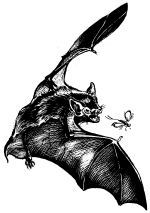 Bats,
those beneficial mosquito catchers, will live together in communities in bat houses near
wet areas. Bat houses can be various sizes, but the common feature is a bottom entry made
by several slats placed one inch apart. The inner surfaces of the house should be
roughened to facilitate climbing, and rough outer surfaces are also helpful. Bat houses
should be kept at a temperature of about 80 to 90 degrees. This can be done by covering
the top with tarpaper, or by painting the house black. The houses should be placed on a
tree trunk, metal pole, or the side of a building, preferably facing east, about 10-12
feet above the ground. If placed on a tree, it should be a fairly isolated one with a
sheet of tin around the tree and under the house to deter raccoons. Otherwise, the bats
will be heavily preyed upon. Refer to the chapter on Bats
in the Species Management section for
information on how to build a bat house. Bats,
those beneficial mosquito catchers, will live together in communities in bat houses near
wet areas. Bat houses can be various sizes, but the common feature is a bottom entry made
by several slats placed one inch apart. The inner surfaces of the house should be
roughened to facilitate climbing, and rough outer surfaces are also helpful. Bat houses
should be kept at a temperature of about 80 to 90 degrees. This can be done by covering
the top with tarpaper, or by painting the house black. The houses should be placed on a
tree trunk, metal pole, or the side of a building, preferably facing east, about 10-12
feet above the ground. If placed on a tree, it should be a fairly isolated one with a
sheet of tin around the tree and under the house to deter raccoons. Otherwise, the bats
will be heavily preyed upon. Refer to the chapter on Bats
in the Species Management section for
information on how to build a bat house.
Boxes that are larger, about 9 x 15 inches, will house squirrels and kestrels. Squirrels
are abundant in back yards, woodlots, and farm groves. The entrance to a squirrel box
should be three inches in diameter and is located on the side of the box instead of in the
front. A piece of wood can be nailed inside the box just below the entrance hole to
provide an observation perch. Squirrel boxes should be placed facing either east or south
at least 15 feet above ground in trees at least 10 inches in diameter. Kestrels are
abundant in agricultural areas with scattered trees. Kestrel houses are the same as
squirrel houses except for the entrance hole placement. These houses should be placed on a
10 to 30 feet high post or tree that is near grassy areas. They should have a sheet of tin
secured around the tree under the house to prevent squirrels from using it.
Raccoon houses are large (12 inches x 24 inches), with an entrance hole of 4
1¼2 inches in diameter. This box should be placed on live or dead trees of at least 12
inches in diameter, at a height of 10 to 20 feet.
Wood duck houses have greatly benefited this species. These houses are 9 1¼4 x
18 inches with an oval entrance hole that is three inches high and four inches wide. This
hole will exclude most raccoons. These houses should be placed on an isolated tree or post
16 feet high, and with a tin sheet secured under the house to prevent squirrel use and
raccoon predation. Watch for starling occupation in these boxes, and remove any suspect
nests.
Shelves and baskets
Robins, Barn swallows, and Eastern Phoebes will utilize nesting shelves. These shelves
are open to the front, but covered on the sides and top. Robins are often seen in
backyards, and their shelves can be placed about six to 10 feet above ground on a wall by
a window or on a tree trunk. Barn swallows are common on farmsteads, and usually
use a mud nest stuck to the sides of a building. Therefore, nesting shelves should be
placed on a house or barn at least 10 to 20 feet away from doorways. Eastern phoebes
are the most common shelf nest builders. Their shelves should be placed under the eaves of
houses near lakes, rivers, or most wooded areas.
Mourning doves and mallards will nest in baskets. These baskets can be made of wire
mesh formed into a cone. Both baskets are similar, but vary in size. Mourning doves
will nest in a basket that is 12 inches in diameter and placed in the crotch of a tree
limb six to 16 feet above ground as far from the trunk as possible. Mallards will
nest in larger baskets. Their baskets have a 26 inch diameter, and are placed over water
on a seven to eight foot support pipe. Placing nesting materials in these baskets will
facilitate use by these species.
Other structures
An underground den for rabbits can be made by placing a wooden box with two side
entrances into the ground and covering it with brush. Each entrance should have three to
four field tiles that lead above
ground. This den should not be placed in areas that are not well drained.
A squirrel den can be made from discarded automobile tires. The tire den should be
placed 15 to 30 feet above ground in a tree with the entrance hole facing the trunk. This
is not as aesthetically pleasing
as wooden boxes, but it is highly functional and a good way to recycle your tires.
In summary, there are many ways to add the habitat component of cover to your property.
Providing homes, either vegetative or structural, is a good way to help fulfill this
requirement in your backyard. Observing the wildlife that use the homes you have provided
is not only fun, but educational.
For more information available on the World Wide Web about "Homes for
Wildlife," please see our Resource Links.
Last Revised: May 5, 2000
|

